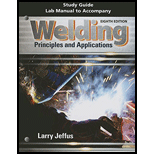
Study Guide with Lab Manual for Jeffus' Welding: Principles and Applications, 8th
8th Edition
ISBN: 9781305494701
Author: Larry Jeffus
Publisher: Cengage Learning
expand_more
expand_more
format_list_bulleted
Textbook Question
Chapter 13, Problem 17R
What bead pattern is best for overhead welds?
Expert Solution & Answer
Trending nowThis is a popular solution!

Students have asked these similar questions
Hi can you please help me with the attached question?
I need the proofs for this equation and derivation of the equation include all graphs needed
Please can you help me with the attached question?
Chapter 13 Solutions
Study Guide with Lab Manual for Jeffus' Welding: Principles and Applications, 8th
Ch. 13 - Why is it important to make sure that an FCA...Ch. 13 - What major safety concerns should an FCA welder be...Ch. 13 - Why should the FCA welding practice plates be...Ch. 13 - Why should the FCA welds be of substantial length?Ch. 13 - What must be done to a shielding gas cylinder...Ch. 13 - What can happen to the wire if the conduit is...Ch. 13 - Why is it a good idea for a new student welder to...Ch. 13 - Why is the curl in the wire end straightened out?Ch. 13 - What problems can a high-feed roller pressure...Ch. 13 - Referring to Table 13-1, answer the following a....
Ch. 13 - What are the disadvantages of beveling plates for...Ch. 13 - What is the maximum plate thickness that an FCS...Ch. 13 - What is the smallest V-groove angle that can be...Ch. 13 - What is the purpose of the root pass?Ch. 13 - Why is the FCA welding process not used for...Ch. 13 - Why should convex weld faces be avoided?Ch. 13 - What bead pattern is best for overhead welds?Ch. 13 - Why is the appearance of the cover pass so...Ch. 13 - What are the visual inspection standard's...Ch. 13 - Why is the backing strip 2 in. (50 mm) longer than...Ch. 13 - Why should there be a space between the plates...Ch. 13 - What would a small notch at the root weld's...Ch. 13 - What changes should be made in the setup for...Ch. 13 - What problem must be overcome if the amperage and...Ch. 13 - How can higher welding speeds help control...Ch. 13 - How can spatter buildup on the welding gun be...
Knowledge Booster
Learn more about
Need a deep-dive on the concept behind this application? Look no further. Learn more about this topic, mechanical-engineering and related others by exploring similar questions and additional content below.Similar questions
- Please can you help me with the attached question?arrow_forward4. The rod ABCD is made of an aluminum for which E = 70 GPa. For the loading shown, determine the deflection of (a) point B, (b) point D. 1.75 m Area = 800 mm² 100 kN B 1.25 m с Area = 500 mm² 75 kN 1.5 m D 50 kNarrow_forwardResearch and select different values for the R ratio from various engine models, then analyze how these changes affect instantaneous velocity and acceleration, presenting your findings visually using graphs.arrow_forward
- Qu. 7 The v -t graph of a car while travelling along a road is shown. Draw the s -t and a -t graphs for the motion. I need to draw a graph and I need to show all work step by step please do not get short cut from dtnaarrow_forwardAn unpressurized cylindrical tank with a 100-foot diameter holds a 40-foot column of water. What is total force acting against the bottom of the tank?arrow_forward7. In the following problems check to see if the set S is a vector subspace of the corresponding R. If it is not, explain why not. If it is, then find a basis and the dimension. (a) S = (b) S = {[],+,"} X1 x12x2 = x3 CR³ {[1], 4+4 = 1} CR³ X2arrow_forward
- AAA Show laplace transform on 1; (+) to L (y(+)) : SY(s) = x (0) Y(s) = £ [lx (+)] = 5 x(+) · est de 2 -St L [ y (^) ] = So KG) et de D 2 D D AA Y(A) → Y(s) Ŷ (+) → s Y(s) -yarrow_forward1) In each of the following scenarios, based on the plane of impact (shown with an (n, t)) and the motion of mass 1, draw the direction of motion of mass 2 after the impact. Note that in all scenarios, mass 2 is initially at rest. What can you say about the nature of the motion of mass 2 regardless of the scenario? m1 15 <+ m2 2) y "L χ m1 m2 m1 בז m2 Farrow_forward8. In the following check to see if the set S is a vector subspace of the corresponding Rn. If it is not, explain why not. If it is, then find a basis and the dimension. X1 (a) S = X2 {[2], n ≤ n } c X1 X2 CR² X1 (b) S X2 = X3 X4 x1 + x2 x3 = 0arrow_forward
arrow_back_ios
SEE MORE QUESTIONS
arrow_forward_ios
Recommended textbooks for you
 Welding: Principles and Applications (MindTap Cou...Mechanical EngineeringISBN:9781305494695Author:Larry JeffusPublisher:Cengage Learning
Welding: Principles and Applications (MindTap Cou...Mechanical EngineeringISBN:9781305494695Author:Larry JeffusPublisher:Cengage Learning

Welding: Principles and Applications (MindTap Cou...
Mechanical Engineering
ISBN:9781305494695
Author:Larry Jeffus
Publisher:Cengage Learning
Differences between Temporary Joining and Permanent Joining.; Author: Academic Gain Tutorials;https://www.youtube.com/watch?v=PTr8QZhgXyg;License: Standard Youtube License